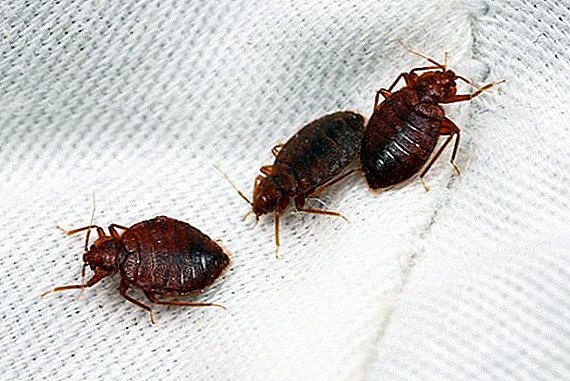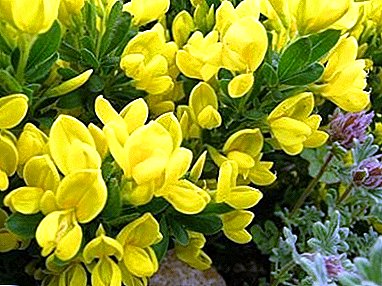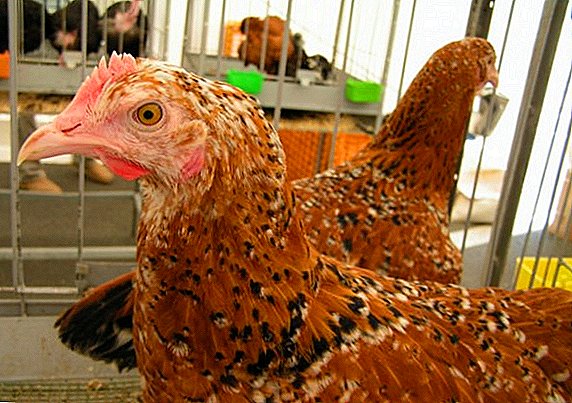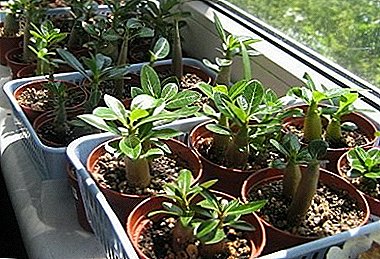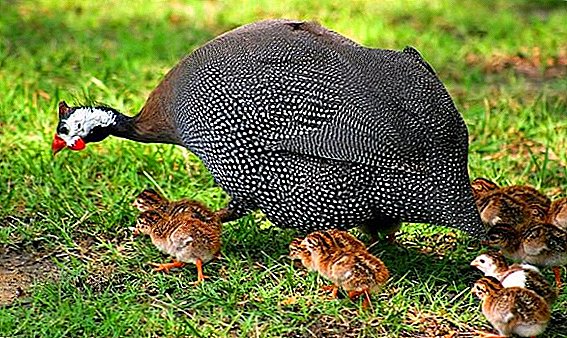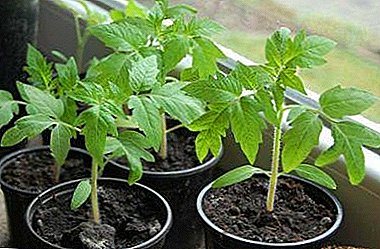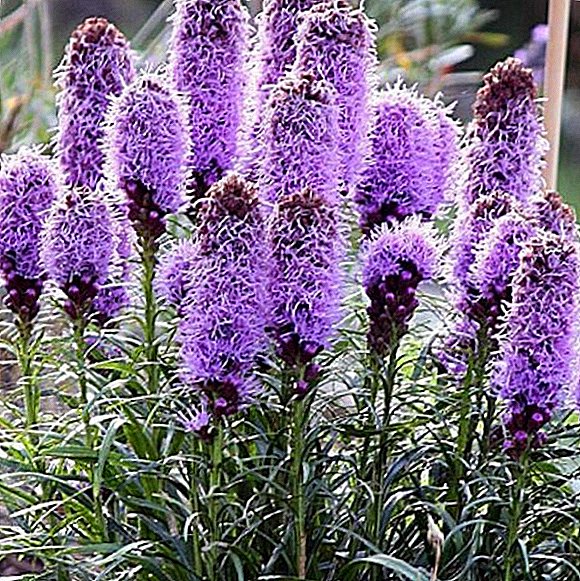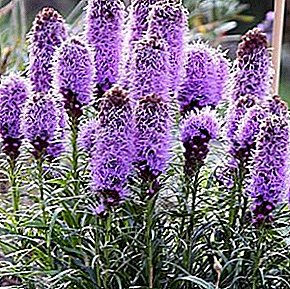 Liatris belongs to grassy plants that attract the attention of long inflorescences like fluffy candles. The shrub belongs to the group of Compositae, among other colors it is distinguished by an elegant rosette of inflorescences resembling a candle.
Liatris belongs to grassy plants that attract the attention of long inflorescences like fluffy candles. The shrub belongs to the group of Compositae, among other colors it is distinguished by an elegant rosette of inflorescences resembling a candle.
A feature of liatris is that its flowers bloom from the top and gradually turn the stem into a fluffy whisk. In addition to the extraordinary beauty, the flower also has healing properties, designers like to use it to create landscape landscapes.
Types of liatris
Unusual plant can reach a height of 1 meter. Flowering occurs in the summer season, it is at this time that shoots appear lush inflorescences up to 40 cm, having a bright rich color. The flower may be white, pink, purple or purple. About what types of liatris occur most often, we describe below.
Spicate
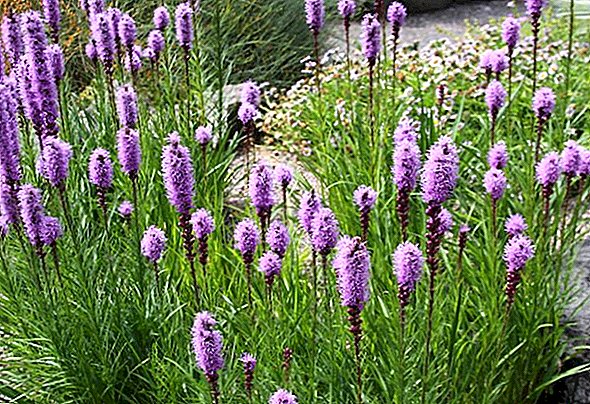
The plant has a low growth, its stems rush up, copiously covered with foliage. Typically, the height does not exceed half a meter. The leaves are smooth and have a bright green color. Flowering dense spike, whose length is 30-35 cm, begins in June - July. Among the varieties most often planted the following:
- Kobold - a plant with pink-purple inflorescences, which are located on the shoots and reach 40 cm;
Important! When planting flowers with seeds, the properties of the variety may not be preserved.
- Florian Weiss - this variety is distinguished by high stems up to 90 cm, at the ends of which there are snow-white candles;
- Florist Violet is a whole set of several varieties that delight lovers of liatris with inflorescences of various shades of purple.
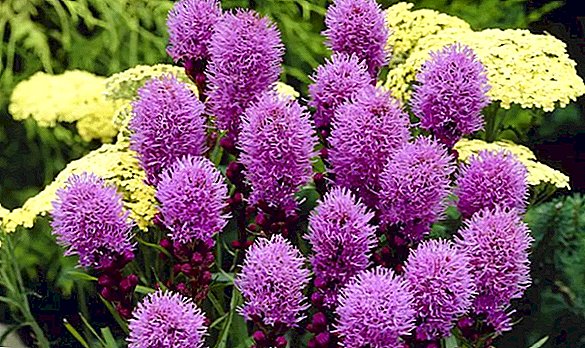
Liatris koloskovy very often can be found at the suburban areas or in parks.
Filmy
This species has rather dense stalks on which the wide leaves having gray-green color are placed. At the top of the plant are lush panicled bouquets, very similar to pompons. Inflorescences are represented by small flowers with a pink and lilac shade. Among this species most often planted such varieties: 
- Alba - a plant with white inflorescences, having soft fragrant flowers;
- September Glory - the plant belongs to the group of tall, among others it is distinguished by large bright pink flowers.
Rough
Upright shoots of this species often form thickets. Their height can be up to 2 m. Many small leaves have a juicy green color. In the upper part of the shoots are short round or triangular inflorescences paniculate type. They have a dark lavender or purple color. White fluffy inflorescences can also be found, for example, in the White Speer variety.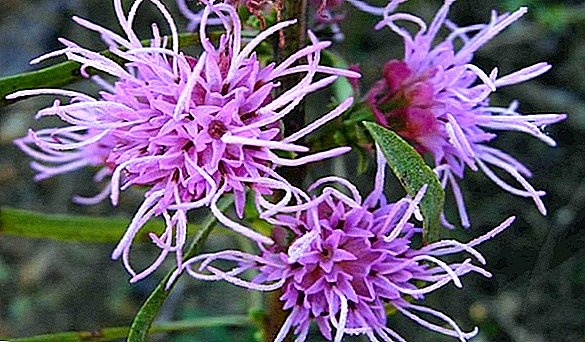
Selecting a site for landing on the site
Before planting a flower in open ground, it is very important to take into account all the nuances of choosing a place. Liatris loves sunny places, bright lighting. A plant planted in a darkened place will grow very slowly, will not be able to bloom and will die in the end result.
Did you know? The highest flower belongs to the Alba variety - its height reaches 1 meter.Pay attention to the quality of the soil. The earth should be loose and light. It is not necessary to plant a flower in the territory with a close location of groundwater.
Clayy, heavy soils should be avoided. In the lowlands the flower will grow very slowly. The drought period is perfect for the flower - it will bloom in front of your eyes and sparkle with a variety of colors.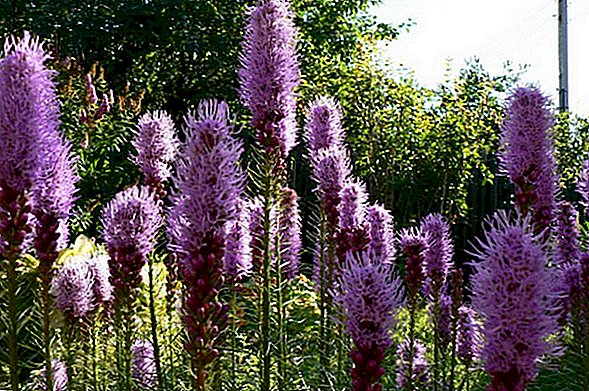
Combination with other plants and use in landscape compositions
Liatris is often used in landscape design.. It goes well with many plants, which also prefer large amounts of sunlight and loose soil. The bush will get along well with any wildflowers, chamomile and gypsophila.
To create an original and beautiful design solution using the liatris, you need to choose the right neighbors. It is necessary to take into account the color, flowering period and, of course, the height of the plants.
Liatris, which has snow-white or purple hues, will look good in combination with a terry daylily of red-orange color. Perfectly complement this ensemble and yellow enotera. 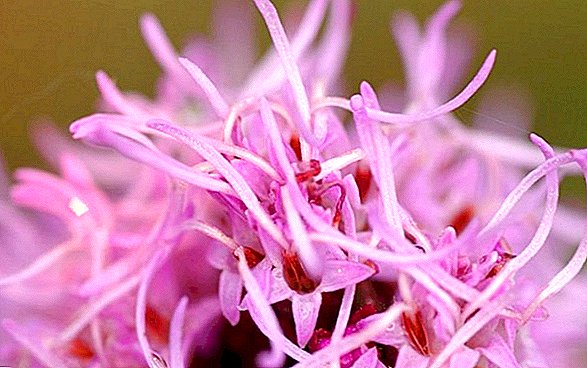
Often to create beautiful landscapes using the Picador variety. His bright red-purple blossoms look perfect with snow-white bells. Also original with him will look stock roses and delicate mallow.
Important! If you want to grow healthy and strong plants from seeds, it is recommended to plant them in greenhouse conditions.In a large flower garden the combination of white liatris and lilac or red monards looks beautiful.
To create rockeries, the most commonly used variety is Kobold. Its height does not exceed 40 cm, and bright violet-purple and purple inflorescences are sure to attract attention.
Often planted liatris in flower beds, next to the adjoining buildings or fences. Recently, this flower began to be used frequently by florists to create wedding arrangements. Having planted a liatris in my flower garden or mixborder, guests will surely drop in to take a photo against the background of a beautiful unusual flower. 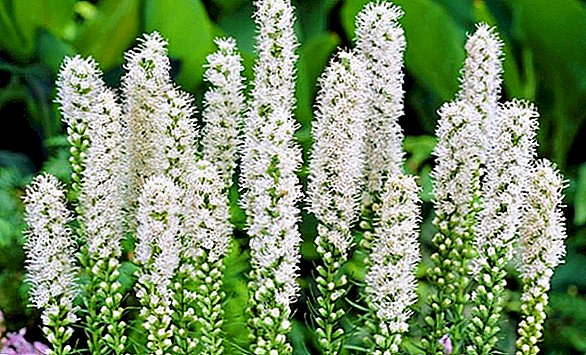
Flowers that will look good with liatrice: daylily, night violet, delphinium, carnation, astilba, lupine, stems, echinacea, irises.
Correct fit
There are several ways of planting the liatris - tubers and seeds. Consider in detail each of them.
Planting tubers
Planting in the spring of tuber tuber is very common among summer residents. Tuber is a small, slightly flattened onion. Despite the division of rhizomes, the plant will grow healthy and full. It will bloom in the first year after disembarkation. 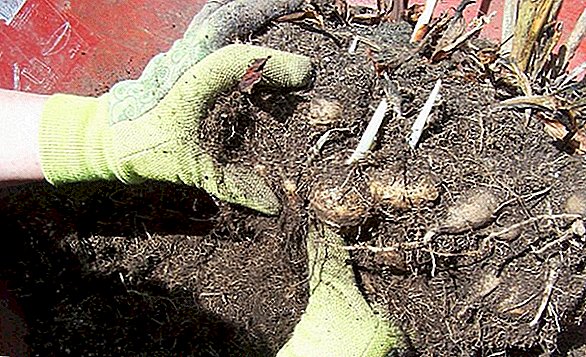
In the autumn period, after the green mass has died, it is necessary to dig up the roots. The bulbs are thoroughly cleaned, dried and sorted. Suitable for planting tubers with a diameter greater than 2 cm.
Did you know? Liatris is actively used in perfumery. Due to the unusual smell of inflorescences, very original aromas are obtained.When planting, it is necessary to deepen the tuber into the soil by about 10 cm. It is recommended to fertilize the soil with compost. Be sure to keep the distance between the holes - about 40 cm. Regardless of how the flowers were planted, about 1 time in 4 years they must be uprooted and the tubers should be planted. May or August is best for such a procedure.
Sowing seeds
Another way to propagate liatris is to grow from seed. The flower is not too demanding and whimsical, so his sowing and care will not give you trouble. 
Planting seeds in open ground should be carried out either in early spring or late autumn. It is not necessary to plant the plant at the place where groundwater is located near the surface.
It is important to prepare the soil: loosen it well, drain it. Liatris grows well on light soils with a neutral pH reaction. Excessive soil moistening can lead to plant rot. Before planting seeds, it is recommended to dig up the ground and add compost or rotted manure to it.
Care features
In order for flowers to grow beautiful and to please the eye, you need to devote time to caring for them. Let us dwell on these points.
Watering mode
Watering plants should be carried out as needed. The flower tolerates drought better, so even if it stays without water for several days, nothing will happen to it. But in rainy periods it is necessary to arrange drainages for the liatris, since stagnation of water near the roots will cause them to rot. Provided that at least once a week it will rain, the flower can not be watered at all. 
Weed removal and hilling of bushes
Any flower will be lost among weeds and other unnecessary grass. As soon as you notice that weeds begin to break through, you must immediately remove them. They will interfere with the normal growth of the plant and prevent its flowering.
Important! If you begin to notice that in the fall the leaves become pale, you must fertilize the soil with nitrogen mineral granules.In addition to loosening the land, it is recommended to pile up the bush of the liatris. This is necessary to prevent stripping of the roots after watering, as well as to give the plant resistance.
Mulching

During weeding, it is mandatory to carry out mulching. Loosen the ground at the base of the bush is not worth it. The fact is that the root system is close to the surface of the soil, so after watering or rain, it is worthwhile to carry out mulching. Carefully inspect the flower and, if necessary, add some mulch material.
It is also recommended to pile and mulch the plant before the winter period.
Fertilizer fertilizer
The plant must be regularly fed with mineral fertilizers. In the spring, it is recommended to apply fertilizers that contain nitrogen, and in the summer to use phosphorus-potassium. To enhance the bloom of liatris, it is worth adding a thick layer of compost to the soil.
Potash fertilizers for your plants: potassium sulfate, potassium nitrate, potash salt, potassium humate, wood ash.
Garter to the support
Some varieties of liatris can grow up to 90 cm in height, so you should definitely carry out their garter. Set pegs next to the bushes or stretch the wire and tie flowers to them. If this is not done, under the mass of large flowers, thin plant stems will quickly break.
Pruning inflorescences
If you begin to notice that some of the inflorescences are down, you need to cut them. This will improve the appearance of the flower, as well as provide an opportunity to enjoy the rich color of the leaves. Often it is necessary to prune liatris when the flowering period comes to an end. 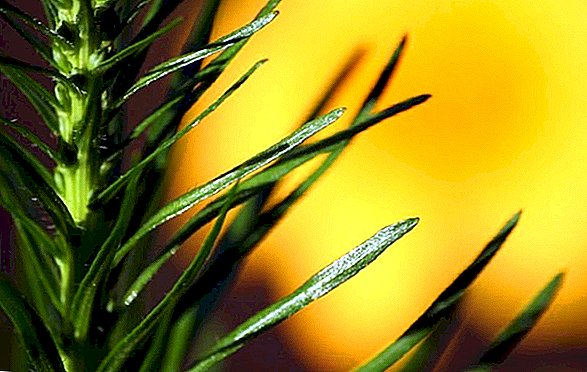
Combating possible pests and diseases
The flower is resistant to diseases and pests. But, if the technology of care and cultivation of the liatris is violated, attacks of snails and polar bears are not excluded. To combat them use beer. Beer is poured into a glass bottle 2-3 cm and placed in the ground. The bottle must be located at an angle of 45 degrees. Pests will come to the smell and fall into the trap, they will not be able to get out of the bottle.
Did you know? The plant has many other names: reindeer tongue, glowing asterisk, cheerful feather.
It happens that because of excessive moisture, the flower begins to rot. In such a situation, it is worth cutting the rot and treating the plant with fungicides. 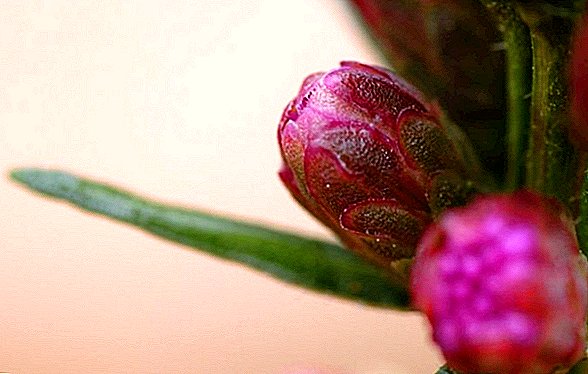
Wintering
By the winter period the plant should be carefully prepared. It is very important to cut the flower under the root. In general, the plant is resistant to cold, so there is no need to create special additional shelters. It will be enough to fill the bushes with dry leaves. Layer thickness should be about 15 cm.
Tuber transplant and division
If you need to transplant liatris to another location, reproduction can be done by dividing the tuber.
Before the landing, it is necessary to prepare the wells, the depth of which should be about 10-20 cm, the distance between them is 30 cm. The third part of the hole is filled with humus, and then the landing is performed. Be sure to perform mulching shoots after planting with humus. Replacing liatris is recommended in March or November. Propagate the plant with this method can be approximately once every 4 years.
Medicinal properties
Liatris is not only a beautiful flower that can decorate any flower bed, but also a widespread medicinal plant.
The decoction of the herb has a pronounced astringent, diuretic and antibacterial action. When using the syrup from the liatris, it is possible to treat pathological changes in the kidneys.
Liatris baths have a good tonic effect, are antiseptic and relieve itching. In order to heal wounds quickly, it is customary to make lotions from this plant; when sore throat, rinsing with liatrix extract helps.
The flower is also useful in the household - its leaves and inflorescences perfectly scare the moth.
If you want to decorate the garden area with an unusual and very useful plant, we recommend you stop the choice on liatris.



